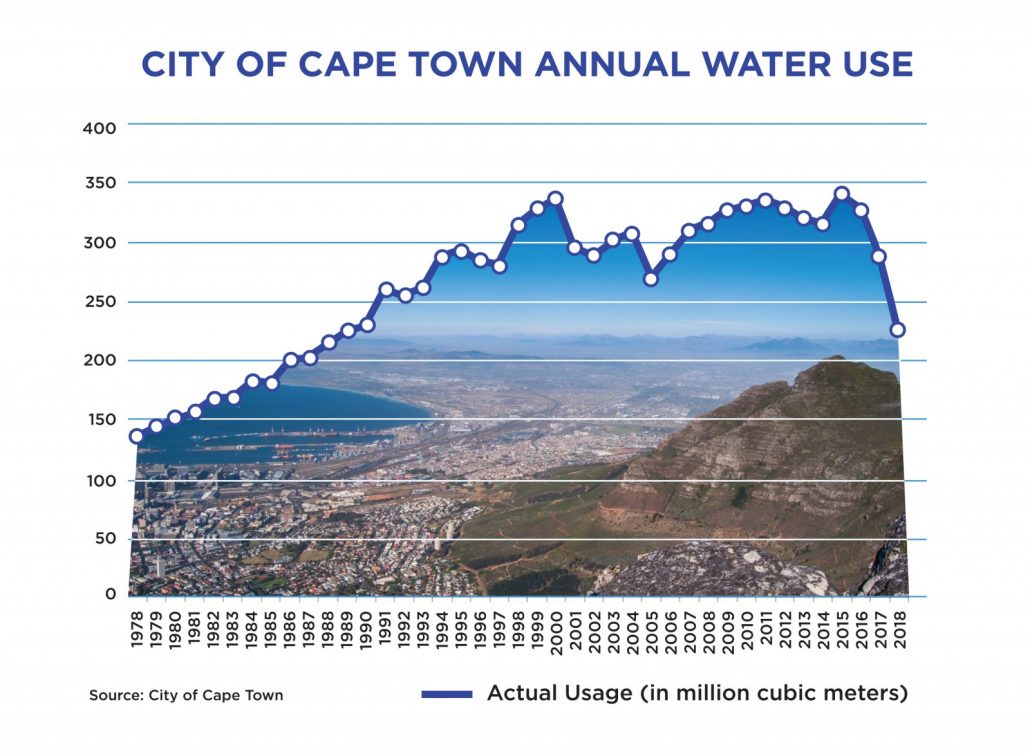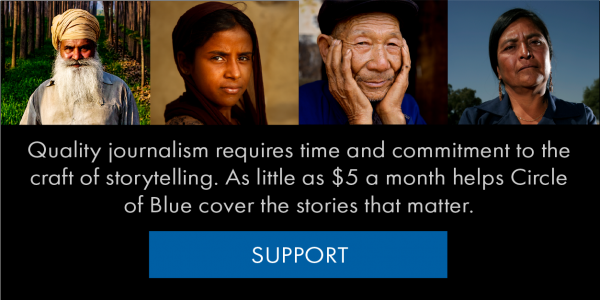
Residents queue to refill water bottles at Newlands Spring on January 31, 2018. Photo © Morgana Wingard/Getty Images
The city of 4 million people almost turned off its taps.
By Brett Walton, Circle of Blue – July 12, 2018
Travel funding for this story came from the Pulitzer Center on Crisis Reporting
CAPE TOWN, South Africa – This is what a water panic looks like in a major global city.
People hoard water. They queue for hours, well into the night, to fill jugs at natural springs. Like mad Christmas shoppers, they clear supermarkets of bottled water. They descend on stockers before they can fill the shelves.
Restaurants, malls, and offices shut off bathroom faucets and install hand sanitizer dispensers. Exhortations to conserve water are plastered throughout buildings. Above one toilet stall at the University of Cape Town a paper placard with a hand-turned dial indicates the number of uses since the last flush. “Be A Wee-Wise Water Warrior. Only Flush After 4 (No. 1’s only),” it reads.
Panic. Residents in South Africa’s second largest city repeatedly used that word to describe the weeks after January 18 when Mayor Patricia De Lille proclaimed that the day the city would run out of water, what was called “Day Zero,” was fast approaching. The declaration hit like a blast wave.
City workers knocked holes into sewer lines so that underground water would seep in to compensate for low flows. Wealthier residents frantically drilled boreholes on their property to access groundwater and move a portion of their water use off the city grid. Well drillers reported being booked for months.
On February 1 — the height of southern hemisphere summer, when water demand is greatest — the city clamped down, harder than any city with its living standards. Officials set a target of 50 liters (13 gallons) per person per day for all domestic uses: cooking, bathing, toilet flushing, washing clothes. Watering lawns and scrubbing cars with city water had already been banned for months. “The abuse of water means that we will all suffer,” De Lille had warned.
The most visible symbol of the water crisis was Theewaterskloof Dam, the main drinking source for Cape Town. The big dam and its five sister reservoirs in the Western Cape system not only supply water for drinking water but also for farm irrigation. After three years of drought, the reservoirs dropped so rapidly six months ago that city authorities warned that they would shut off water to homes and businesses unless residents embraced strict water-saving practices.
The goal was to keep the reservoirs from being completely drained, unleashing a catastrophic scenario — a major city starved of water, an economy constricted, millions of residents hauling daily water rations from sanctioned collection points, the potential for disease outbreaks and violence.
In those terrifying months earlier this year turnouts along the R45 highway, an hour east of Cape Town, became vantage points to view the calamity. Theewaterskloof Dam, and its largely empty reservoir, lay below. Steady winds raked the empty plain on a warm April afternoon, lifting up curtains of dust. A herd of oryx grazed warily while songbirds flitted among dead trees, their branches bleached and spiky like fish bones.
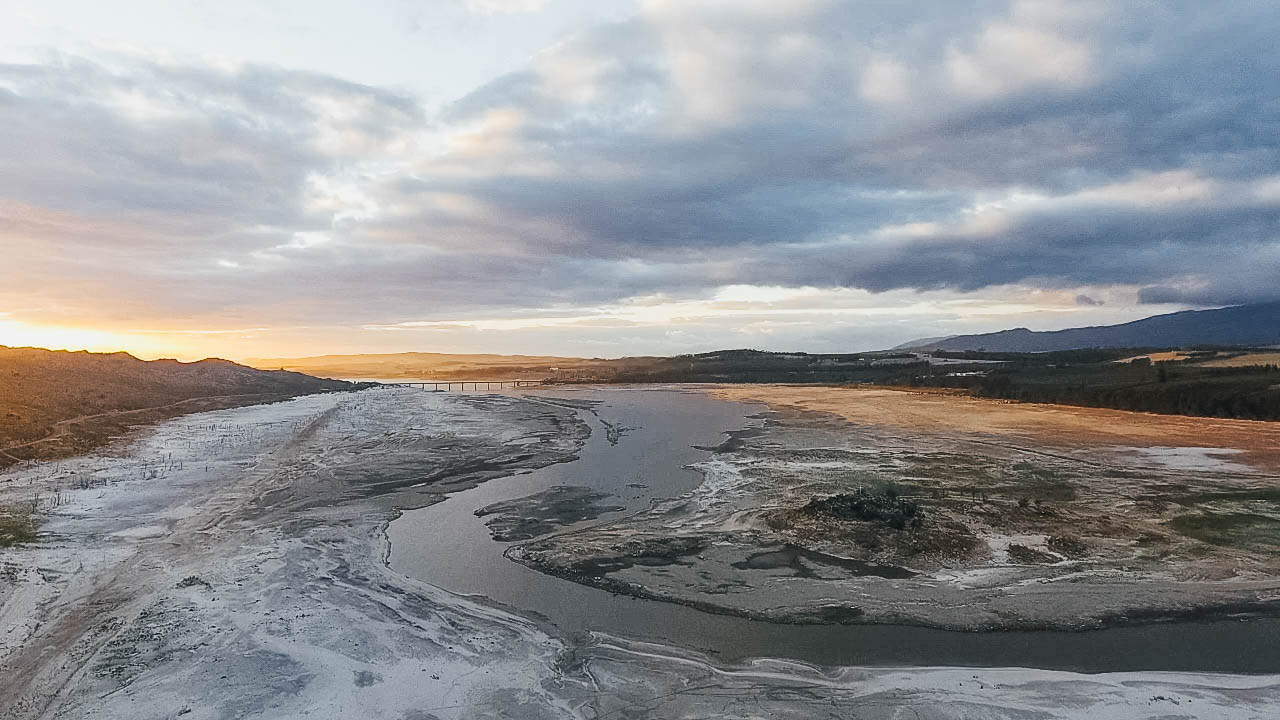
Cape Town’s main supply reservoir, Theewaterskloof Dam, dipped to 15.5 percent capacity on January 15, 2018. A month later it dropped below 11 percent. A temporary coffer dam was built inside the dam to pool the last 10 percent of supply, making it easier to be pumped into the canal that feeds the city’s water system. Photo © Morgana Wingard/Getty Images
By July, Cape Town looks to have evaded a water catastrophe, at least for this year. Residents are using substantially less water. Severe water supply restrictions instituted on agriculture and city dwellers alike, and a heroic, last-ditch conservation effort halted the swift drop in reservoir levels. Winter rains are now providing some relief. The amount of water stored in the reservoirs more than doubled in the last month and rivers in the Western Cape swelled in downpours. Snow graced the mountain peaks. The start of the wet season this year is more promising than any of the last three.
The city’s near-death experience, though, is revealing for the gorgeous seaside city at the southern tip of Africa. And it offers lessons in the immense challenges fast-growing and drought-prone cities all over the world face in making adequate supplies of water available in the era of intensifying hydrological disruption. Other big cities also contend with severe water shortages, some that prompt civic violence. They include Beijing and São Paulo; Chennai, New Delhi, and Bangalore in India; Karachi, Amman, and Mexico City.
The Western Cape drought and the subsequent receding of Cape Town’s reservoirs exposed individuals and businesses to months of hardship and anguish. It laid bare the inadequacies of institutions, laws, and leadership to recognize and respond quickly enough to severe water shortage. The drought magnified the city’s racial and economic divides, which are legacies of apartheid.
The planning’s been there. The planning’s been there for a long time.” Kirsty Carden, University of Cape Town
It also unveiled the precarious risk calculations that local and national authorities charged with safeguarding Cape Town from just such an emergency had to make. Those authorities and their agencies have been aware for years of vulnerabilities in the Western Cape water system. They even drew up careful plans to address weaknesses. Yet after more than a decade of planning, and regular meetings to discuss drought-related risks, they determined that they could keep delaying the date at which they needed to invest in new water supplies. As it turns out, they waited too long. Severe drought took hold and the Cape Town region slid to the brink of catastrophe.
“The planning’s been there. The planning’s been there for a long time,” explained Kirsty Carden, a researcher at the University of Cape Town’s Future Water Institute. “But in reality water resources managers plan for nothing more than 98 percent assurity” — or, a 2 percent chance of a water shortfall — “so they’re not planning for anything that’s going to take them out of the normal planning regime because there are other priorities for spending for local and national government, particularly in a country like South Africa.”
A City on Edge
Three police vehicles pull into a shopping center parking lot in Wynberg, a leafy, middle-class district of Cape Town.
“This is a place we always monitor,” says Warren Brandt, a take-charge officer on the lookout for water waste. Yes, water waste. Brandt says that the parking lot is a known depot for taxi washing, which is now illegal under city bylaws. In dystopian futures, this a scenario that sci-fi authors envision.
Leading the convoy, Brandt’s vehicle pulls up next to a minibus. A man in a knit cap and orange reflective vest peers sheepishly from beside the vehicle, a bucket at his side. “This is not the first time we’ve fined him,” Brandt says while another officer writes a R500 ticket, roughly $35.
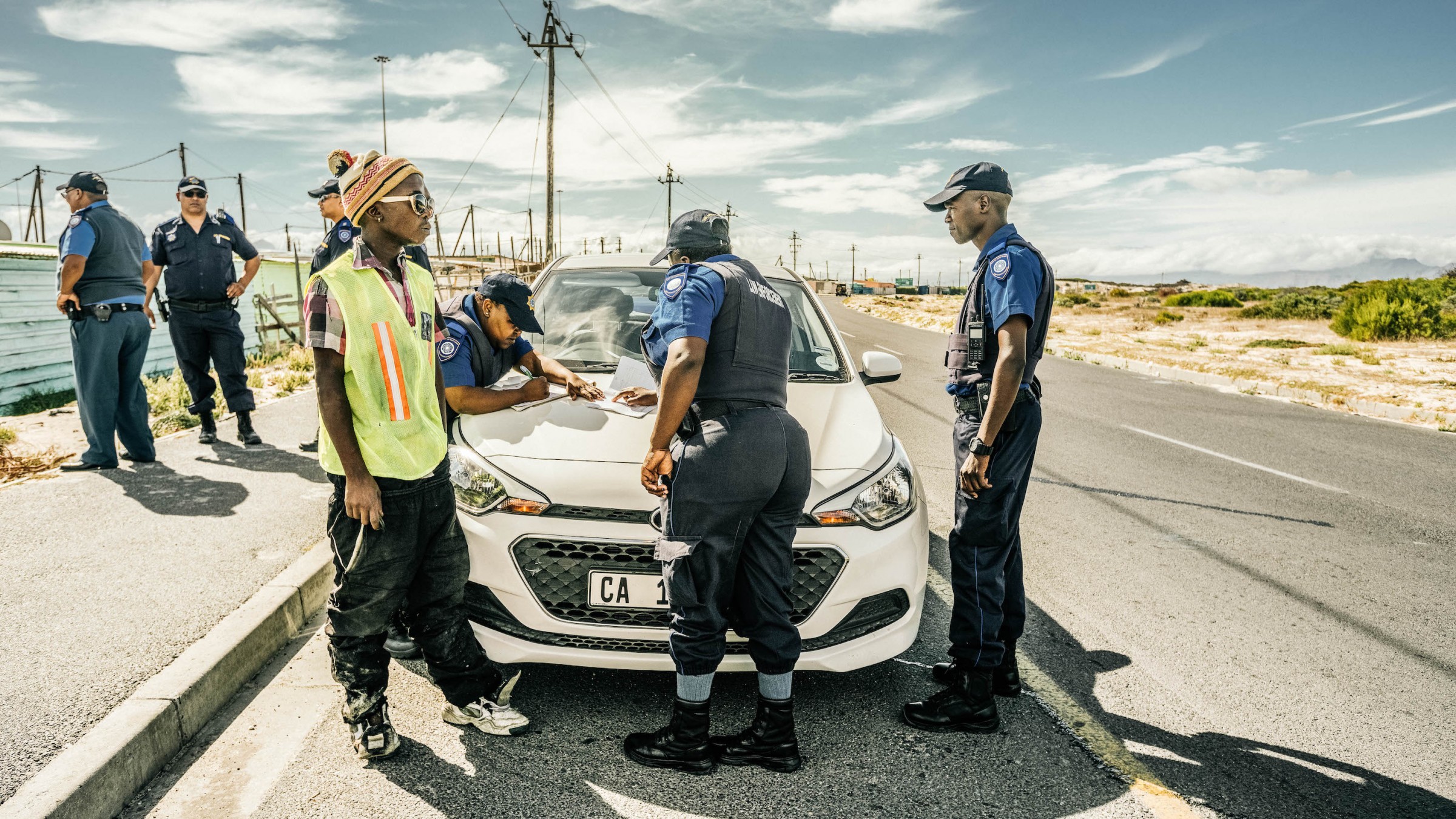
Law enforcement ticket a man on March 7, 2018 for unlawful water usage in a car wash in Khayelitsha. When officers arrived three men took off into the maze of shanties. Officer Vityo caught one man, handcuff him and carried him back where he was issued a fine. Photo © Morgana Wingard/Getty Images
The law enforcement department stepped up its policing of water waste in January, when the water crisis in Cape Town reached a crescendo. “I mean that was really the crisis point at which panic set in,” Ian Neilson, the deputy mayor, told Circle of Blue during an interview in a City Hall conference room.
The rout on the city’s nerves was set off by Mayor De Lille’s Day Zero announcement. Her authority did not last much longer. The next day, owing to unrelated charges from her party of mismanagement and corruption, the City Council revoked her responsibility to oversee drought response, and Neilson took command.
Neilson said he had two immediate tasks: drive down water use, which was the only response the city could muster in the short term, and improve communication with residents. Hopes of a “quick win” — rapidly boosting supply from a fleet of small-scale desalination plants — proved to be illusory after consultation with World Bank experts, Neilson said. Acquiring, delivering, and installing the plants would have been too expensive, too slow, and useless over the long-term because the cost per unit of water was so high.
Day Zero did not mean no water would flow into Cape Town; it meant the city would dramatically reduce demand by controlling the points at which people could access water. That was to be achieved by cutting off households and requiring them to queue at more than 200 public collection sites. It was conservation by extreme rationing, with a goal of cutting city demand to 350 million liters a day. If it had to be implemented, the Day Zero plan would have extended supplies by three months, buying time until the return of the rainy season, which runs from May until September.
That made communication all the more important. Sending clear messages was necessary to keep residents aligned with the water-saving mission. For Neilson, it meant putting out as much information as possible on dam levels, water consumption, and the progress of infrastructure projects that will, eventually, bring new water to the city.
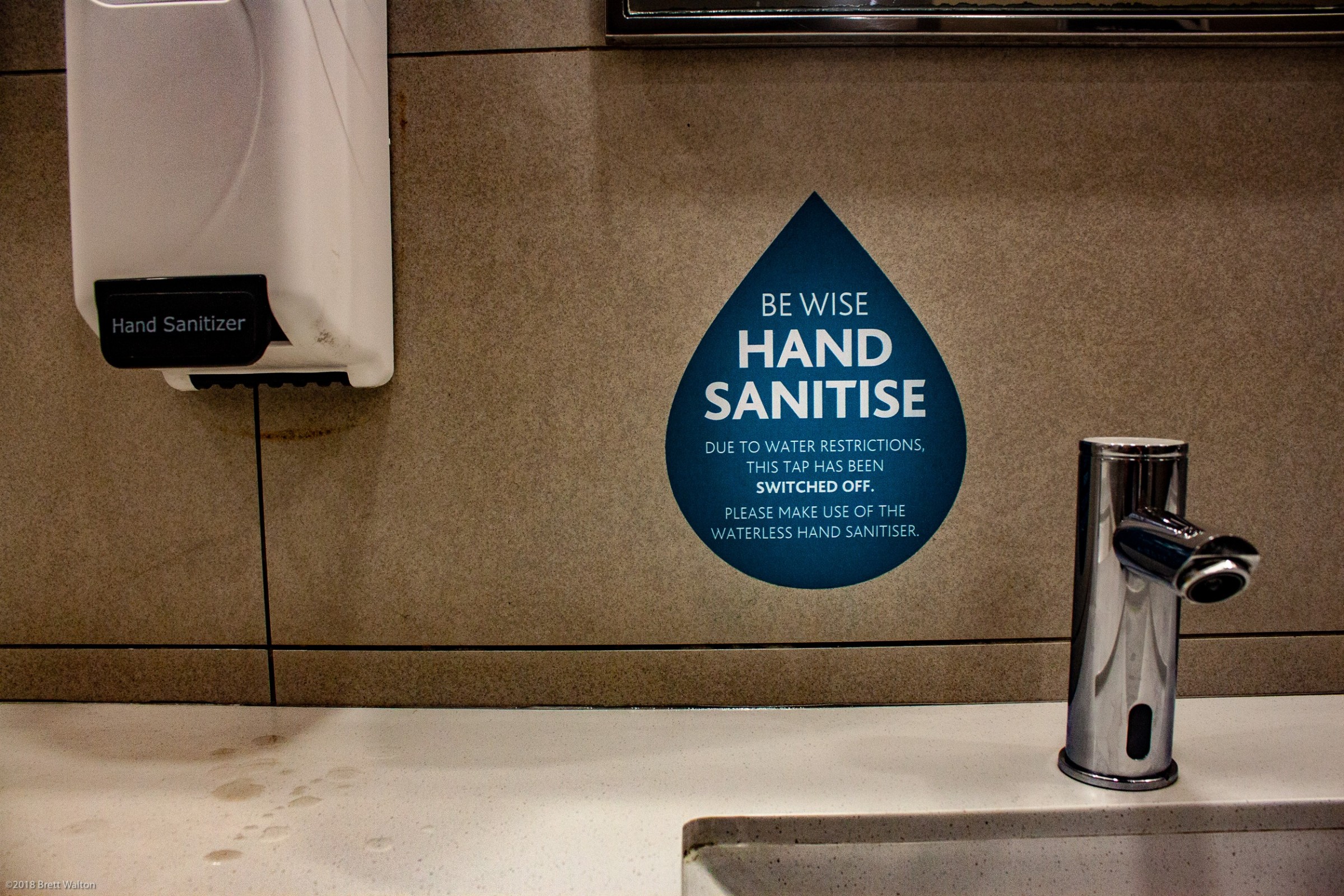
Many office buildings, restaurants, and hotels in Cape Town shut off water to bathroom faucets during the water crisis. Photo © Brett Walton / Circle of Blue
Day Zero was always a moving target. City officials dutifully updated the projections each week based on the previous week’s consumption. Use less, and Day Zero retreated. Use more, and it moved forward.
“People will say, ‘I’ve had enough. I want a decent bath again,’” Neilson said, explaining the need to reinforce the conservation gospel. “We have to keep the message up. We have to keep them on board. The only way I see that can be achieved is that we have to be open and frank and truthful. We put out the information good or bad. The fact that consumption went up 5 percent this week [in April], we put it out, we said it.”
After the January panic, the Day Zero date began to move farther and farther into the future. Demand, which had been stuck around 600 million liters a day, fell closer to 500 million as restrictions and higher water rates started to bite. If residents didn’t adhere to water-use limits on their own, the city put them on a leash. Between October 2017 and May 2018, city workers installed more than 46,170 “water management devices” that throttled the flow of water into homes that used more than 10,500 liters a month.
Then at the end of February, the farm sector, which was allocated one-third of the water from the Western Cape system, reached its limit. With farms not drawing from the reservoirs anymore, the pace of decline slowed.
Cape Town also received an unexpected bonus. The Groenland Water User Association, a farmers’ group, announced in early February that it would release water from its own dams into city reservoirs. That donation amounted to roughly two weeks of municipal demand.
‘Everything Relies On This’
Ensuring that the Day Zero scenario never came to pass was the task of a group of local, provincial, and national government officials who began detailed discussions about water supply in the Western Cape more than a decade ago. The need was obvious. The Cape Town metropolitan region was growing by more than 65,000 new residents annually. And climate change scenarios forecasted that the region would steadily get drier and warmer. On September 20, 2007, the Strategy Steering Committee met in the Cape Town office of Ninham Shand, a South African engineering consultancy that provided technical analysis to the group. Seventeen people were present at that first meeting, but attendance at later gatherings would grow to roughly 30 as more agencies became involved.
The national Department of Water Affairs and Forestry — the predecessor to the Department of Water and Sanitation — led the meeting. Also in the room were municipal officials from Cape Town, Saldanha Bay, and Cape Winelands. The Department of Agriculture and Cape Nature, the agency responsible for biodiversity conservation in the Western Cape, sent representatives, as did the Breede River and Berg River water users associations, which supply water to farmers.
Johan van Rooyen, director of integrated water resources planning at the Department of Water Affairs and Forestry, began the meeting by reminding participants about the boundaries of their mandate.
“Although this SSC has no decision making powers, it is very powerful and important, because the recommendations that it makes will have far-reaching consequences,” van Rooyen said, according to the meeting minutes. Its power, he explained, came from the political connections of its members. They could persuade local and national leaders, who had the authority to act on the committee’s recommendations.
The SSC’s purpose was to guide the region’s response to findings from the Reconciliation Strategy Study, an influential report published in 2007 that projected supply and demand from the Western Cape Water Supply System through 2030. The Western Cape system is the network of dams and pipelines that supply Cape Town, nearby municipalities, and farms. Theewaterskloof is the system’s largest reservoir.
The assessment found that under a low-growth scenario, considering population and economic development, the system would need an infusion of water after 2015. In the high-growth scenario, that date moved forward to 2011. The study also acknowledged a fundamental risk for the region’s water supply: it was too dependent on reservoirs and thus vulnerable to a long drought, especially if climate change resulted in less rainfall.
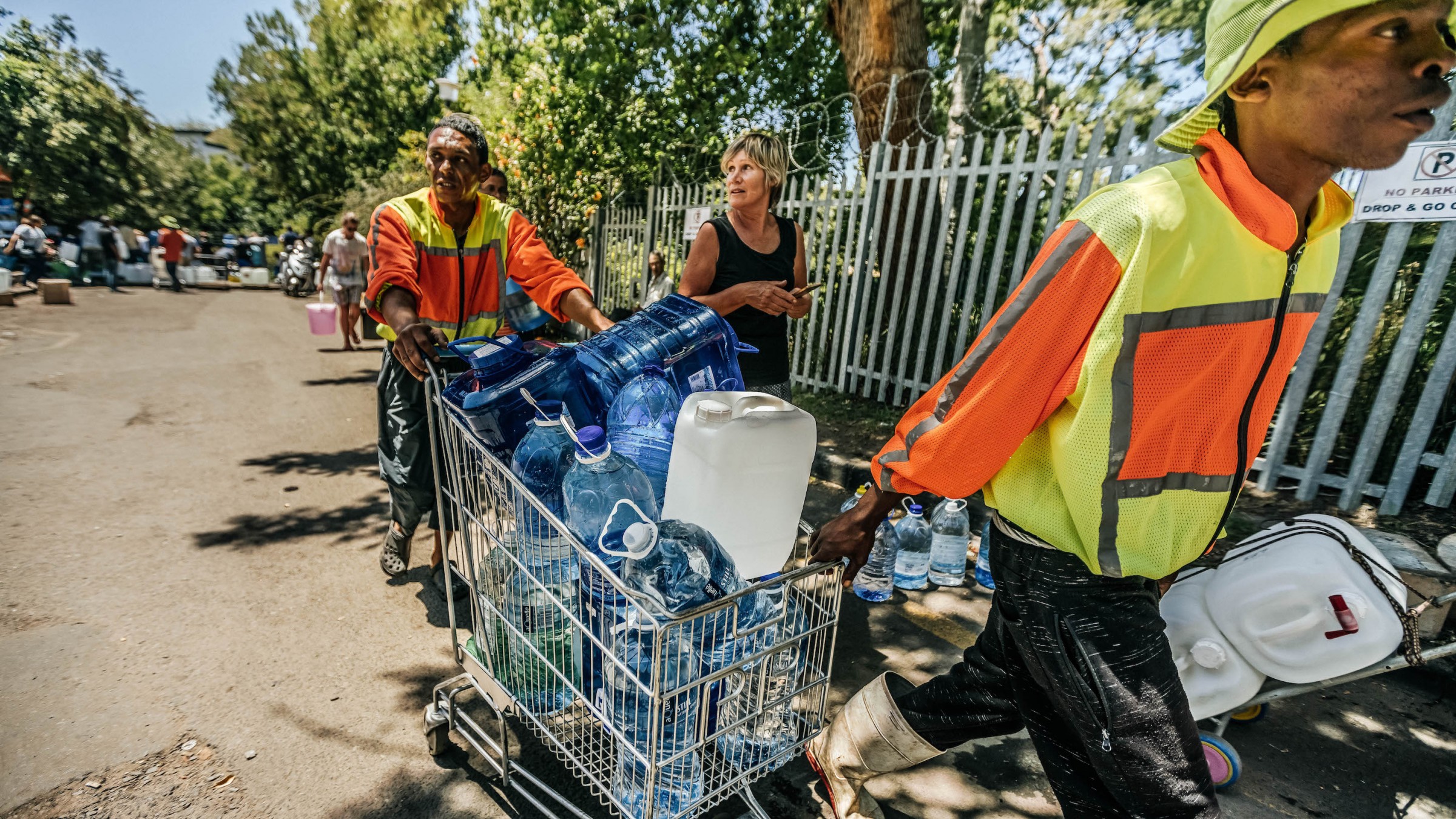
Residents fill jugs in January 2018 with water from Newlands Spring, in the city’s Newlands neighborhood. Photo © Morgana Wingard/Getty Images
In its eight years, the committee would wrestle with two main questions: When would the Western Cape system need to be augmented? And what was the best way to do so? The options under consideration were largely the same suite of choices that Cape Town is evaluating today: tapping groundwater basins, allowing rains to soak into aquifers, cleaning municipal wastewater for reuse, diverting additional water from rivers, clearing invasive plants from mountain catchments, and removing salt from ocean water to make it potable.
A crucial variable was Cape Town’s demand. Because the city accounted for roughly three-fifths of the system’s water use, a large increase or decrease would dictate the speed with which new sources of water were needed.
“Everything relies on this,” Paul Rhode of the Cape Town Water Department said at the September 2007 meeting. Tracking changes in demand was labelled an “urgent action.”
After seeing the results of the strategy study and as part of a deal with the national government over a just-completed reservoir in the Western Cape system, Cape Town authorities pledged, in 2007, to slow the growth in water demand and, if possible, reduce it. They aimed to do so by patching leaks, installing new meters, reusing wastewater, and decreasing pressure in the distribution pipes, which would cut the flow rate to household taps. The approach was partly a matter of picking low-hanging fruit, but also a way to delay as long as possible the need to build expensive infrastructure projects like desalination. Thriftiness was seen as a virtue.
Early on, the committee was concerned that Cape Town’s demand management program was not succeeding. At the November 2011 meeting, a consultant pointed out that water use was still growing between 2 and 3 percent per year, a midpoint between the high- and low-growth scenarios outlined earlier.
Then, as so often happens with long-term planning that occurs without immediate urgency, other tasks took priority and the committee went on hiatus for two years. When the committee did meet again, on August 28, 2013, there was even less urgency. Circumstances had changed. Cape Town’s efforts were starting to bear fruit. Total water use in the city had slightly decreased in the last two years, thanks in part to above average rainfall.
According to the minutes, Peter Flower, then the Cape Town director of water and sanitation, concluded that “there is enough time to make decisions regarding the next intervention. It is not as tight as it was in 2011.”
Committee members looked at the data and projected that new supply would not be needed until 2019.
Confidence in the demand management program strengthened when Cape Town water use, after consecutive wet years, ticked down nearly 2 percent in 2014. By the April 2015 meeting, consultants working with the group were projecting a 2022 target for the next supply project. That year, Cape Town won an international award for its water conservation work from C40 Cities, a coalition of major metropolitan areas focused on addressing climate change.
Then Mother Earth got serious. It started with the weather, which had taken a dry turn. According to the South African Weather Service, 2015 and 2017 were the two driest years in the Cape Town region since 1921. Three consecutive outlier years were more than the system could handle, not without severe restrictions.
Inflows to the Western Cape system reservoirs in 2015 were 54 percent of average. Cape Town residents responded to dry conditions by using more water. Demand rose by nearly 9 percent, wiping out the conservation gains. In 2016, inflows were 66 percent of average. In 2017, the year that nearly broke the system, just 40 percent.
“What happened here was that the three years and particularly the third year, 2017, as the lowest ever on record for us in Cape Town, really caught them out,” Kirsty Carden, the University of Cape Town researcher, told Circle of Blue.
Politics and Mismanagement Interfere
In the depths of the Day Zero panic, politicians started pointing fingers. There was blame and mismanagement aplenty, driven by a culture of distrust that pervades South African society.
Western Cape and Cape Town are governed by the Democratic Alliance, the opposition party, which controls one of South Africa’s nine provinces. The DA leadership faulted the ruling African National Congress for delaying a disaster declaration and not ensuring the adequacy of water supply to cities, which the Constitution deems a national government responsibility.
In Parliament, ANC politicians countered that the Democratic Alliance was grandstanding during a crisis.
“I’m sick and tired of giving you money and you do nothing and you blame the national department,” Pamela Tshwete, deputy minister of water and sanitation, said at a March 8 hearing.
Close observers said the accusations were a distraction and did not reflect years of on-the-ground cooperation that was evident in the SSC meetings and continued today. Trevor Balzer, who was leading the Department of Water and Sanitation’s drought response, said that at a technical level national, provincial, and local leaders collaborated closely. “It feels like a team effort,” Jane Reddick, a water sector analyst at GreenCape, a green business NGO, said. Mike Muller, a former director of the Department of Water Affairs and Forestry, also dismissed the narrative of political discord as a diversion.
Muller instead pointed to a water supply planning process that he said was well-intentioned but misguided. He argued that relying so heavily on controlling demand was inappropriate for a rapidly growing city dependent on rainfall. Cape Town boomed in recent decades, adding 1 million people in the last 15 years. And not everyone in this economically divided city has water service at home. Some 12 percent of households — those on the periphery in what are called informal settlements — have to collect water from a community well. Those households account for a disproportionately small share of the city’s water use, about 4 percent.
Could Cape Town have pushed harder for a water supply project or invested in its own?
“Clearly we could have,” Neilson said. “If we’re doing it now we could have done it earlier too. The question was whether there was appropriate perception that they were needed at this time.”
Muller said that the city’s confidence in its demand management sent a clear signal to the national government that it did not need to fast-track a supply project for the Western Cape system.
“In a sense it was the city saying, ‘No thanks, we don’t want it.’ It was a very strong statement from Cape Town,” Muller told Circle of Blue.
If Cape Town was not going to campaign for additional supply, the national government was in no position to do so either. Carden said there were too many other spending priorities for a country in which one in six people do not have clean water piped to their homes.
At the same time, the Department of Water and Sanitation, which operates the Western Cape system, was coming under scrutiny for mismanagement and unjustified spending. A report in 2017 from the South African auditor general described a department whose leadership had taken it off the rails. The report noted poor planning, inadequate financial management, a breakdown in spending controls, insufficient monitoring of project spending, and a lack of accountability.
It’s always isolated as this problem in Cape Town that needs to be looked at, scrutinized, analyzed. And yet the similar situations that do not affect the rich are almost irrelevant.” Themba Godi, Member of Parliament
The department also did not enforce water-use restrictions in 2016-17 from the Western Cape system. Rashid Khan, regional head of the Department of Water and Sanitation, told Circle of Blue that the department did not prosecute because “the city was trying its very best to bring use down.”
Then in February of this year, the Standing Committee on Public Accounts, a parliamentary body that investigates misuse of public funds, opened an inquiry into the finances and management of the Department of Water and Sanitation. It is the third inquiry into a public institution that the committee has taken on in its history, after probes of Eskom, the national electricity provider, and SABC, the national broadcaster.
Themba Godi, the committee chair, told Circle of Blue that the investigation will not focus on the response to Cape Town’s drought. That crisis, he said, is a problem for the wealthy, echoing the argument that there are people in South Africa who have never had running water.
“It’s always isolated as this problem in Cape Town that needs to be looked at, scrutinized, analyzed,” Godi said. “And yet the similar situations that do not affect the rich are almost irrelevant. So I become an accessory in reinforcing and sustaining that outlook that says that things that affect the rich should become headlines. Our engagement with the department has nothing to do with how its ineptitude has led to some of the challenges that are affecting Cape Town. It is much, much broader than that.”
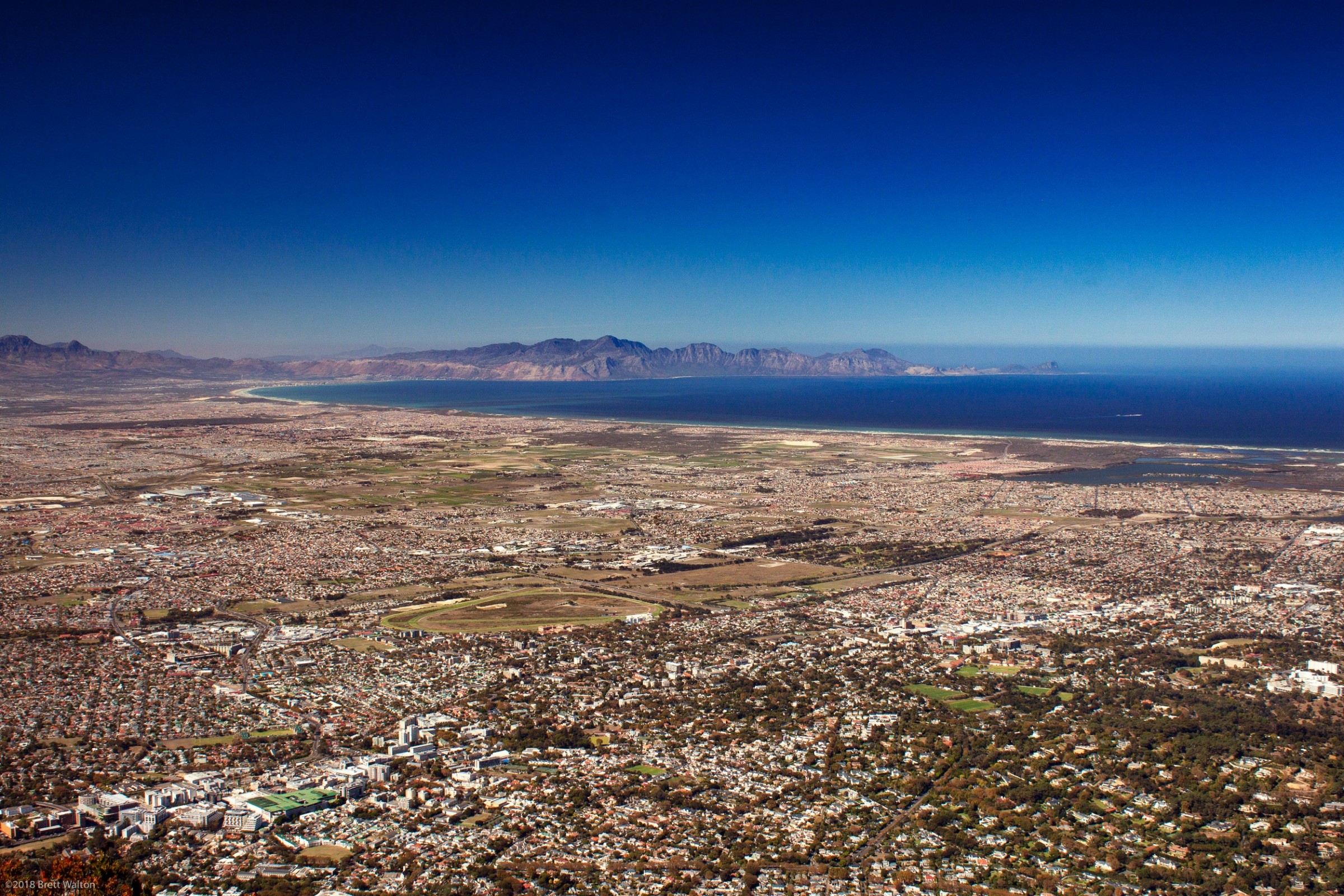
Sprawling east from Table Mountain, the Cape Flats are home to many of the city black and poorer residents. In the foreground is the wealthier Newlands district. Photo © Brett Walton / Circle of Blue
In some ways, the crisis both amplified and collapsed the economic and racial gulf between black and white South Africans, a lingering anguish of apartheid. Homeowners in upscale and largely white Constantia and Newlands were not immune to the harsh restrictions on use of city water. They took 60-second showers while standing in buckets, and let the yellow mellow. Living on 50 liters a day “raised awareness in a lot of people who ordinarily would not have any concept of how a person in an informal settlement lives,” Carden said. Those wealthy homeowners, though, also could afford to drill boreholes to keep their gardens green.
There was panic in the city, but it was not evenly distributed. In informal settlements and townships on the edge of the city, the home of poor black residents, Day Zero had little resonance for people who collect water from community wells. “As a black person, the water restrictions are not that different,” said Loyola Nyathi, a third-year student at the University of Cape Town who is from Khayelitsha, one of the most well-known townships. Others in the city noted that this was a crisis for the middle and upper classes.
Future Planning
Though life under the Day Zero warning may not have changed for people in Khayelitsha and the informal settlements, damage elsewhere was widespread.
Farm employment in the Western Cape was hit particularly hard: an estimated 7,000 job losses in the first quarter of 2018 compared to a year earlier, and a wine harvest that dropped 15 percent. The tourism sector, too, was pummeled, with bookings down 10 to 15 percent during the summer. Chris van Zyl, group sustainability manager at The Vineyard Hotel, told Circle of Blue that the hotel lost several big conference bookings at the end of January, when the mayor announced a Day Zero date. Because pools were drained and unwatered rugby pitches had the cushioning of a sidewalk, recreational options for Capetonians were limited.
“The government says that we’ve done really well, and yes, we’ve brought water use down. But it’s come at a very high price,” said Rene Frank with Save Our Schools, an organization that works to keep water flowing at schools during the drought.
Others criticized the tone of the city’s drought communication, and the panic it induced.
“The concept of Day Zero was very successful in terms of reducing demand, but at the same time it had an impact on business confidence,” said Reddick of GreenCape.
We have to get back to a stage where there is more water available. We cannot stay like this forever.” Ian Neilson, Cape Town deputy mayor
Cape Town is building back its supply in stages as it prepares for a future that climate scientists expect will be drier. Another surface water project — to draw surplus winter flows from the Berg River — is due to start construction in 2019 and be ready to deliver water by the end of 2021.
At the same time, the city is undertaking the diversification that was recommended more than a decade ago in the Western Cape water supply assessment.
The first step, as recommended by World Bank consultants, is to drill for groundwater. The city is investigating three aquifers, the first of which, the Cape Flats Aquifer, is expected to produce water for drinking by September.
The second step is to reuse waste water, a source with massive potential that other coastal cities such as Los Angeles are starting to embrace. Currently Cape Town recycles only 8 percent of its water. The rest goes into the ocean.
Third is desalination, the most expensive option per liter of water. Three tiny units producing 16 million liters a day combined (4.2 million gallons), like desktop toys compared to the need, are going into service this year. Longer-term the city is thinking larger, a facility in the range of 120 million to 150 million liters a day (32 million to 40 million gallons). It is reliable water, but it is costly. And, adds Christine Colvin, a freshwater specialist with WWF-South Africa it uses a lot of energy. In South Africa that means coal-fired power, which produces 90 percent of the country’s electricity and is a huge consumer of water. Desalination “is the biggest carbon footprint of water and biggest cost of water,” she told Circle of Blue.
Combined, these projects could increase the city’s supply by 350 million liters a day by 2021.
More options are on the table. Some, like trapping rainwater in backyard tanks, are small in scale and already saw widespread adoption during the drought. Others take more coordination and money. WWF-South Africa argues that non-native vegetation in the mountain catchments should be cleared. Gum trees, pine trees, black wattle and other species brought by European settlers suck up as much as 7 percent of runoff, a percentage that will grow in the coming years if not addressed. “It’s not a problem we can ignore because if we ignore it, it will get worse,” Colvin said.
Underlying those supply-side interventions is a renewed discussion about the city’s needs and the cost of achieving more secure water supplies. Residents proved they could get by with only 50 liters per day. But it was not comfortable, and according to Neilson, not sustainable.
“Clearly across the board there are consequences of having less water,” Neilson said. “We have to get back to a stage where there is more water available. We cannot stay like this forever. This is a crisis situation. We all pulled together to get through the crisis, to make sure our dams do not run empty. But we cannot be there forever. We have to progressively, within our financial means build the city’s water supply capacity back to something more suitable.”
Correction: Christine Colvin works for WWF-South Africa, not The Nature Conservancy
Cape Town Timeline
Brett writes about agriculture, energy, infrastructure, and the politics and economics of water in the United States. He also writes the Federal Water Tap, Circle of Blue’s weekly digest of U.S. government water news. He is the winner of two Society of Environmental Journalists reporting awards, one of the top honors in American environmental journalism: first place for explanatory reporting for a series on septic system pollution in the United States(2016) and third place for beat reporting in a small market (2014). He received the Sierra Club’s Distinguished Service Award in 2018. Brett lives in Seattle, where he hikes the mountains and bakes pies. Contact Brett Walton

